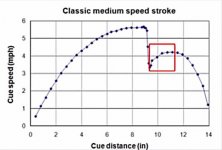After watching the video "Billiards Inside Secrets", which CJ says demonstrates the "hammer" stroke, I have a few things to point out! CJ, you say (regarding the hammering of a nail) "Although it isn't the action that is happening in the stroke" then you say (again regarding hammering of a nail) "Feel that same motion, that kinetic energy that is going to be transferred to the tip". These are your own words in comparing the hammer stroke in pool to the hammer stroke in hammering a nail. My question is, if it is not the same motion...how can you feel the same energy?
In this same segment you demonstrate the hammer stroke at the pool table. IMO the "power" stroke you use is actually a piston stroke. Evidenced by the elbow drop from backstroke to impact. This is not to say, you can't add power to the "piston" by gripping the cue in a "strong athletic position" because you do. However, it is also evident in the video, there is no wrist action. Yes, the wrist is "hinged" (that is how you create the tension to power the piston) but it never unhinges until after impact. In fact, it appears to simply pronate (evidenced by the knuckles and the "V" created by the thumb and index finger). It is true, you hold the cue in a hammer-like grip but it is not used nor creates the same motion as it would in other sports. You have said this yourself about the motion. Additionally, it is evident that you do not hold the cue in your fingers. If you did, the heel of your palm would not touch the cue butt handle at any time except follow through. In golf, your grip is referred to as a "palm grip" and it is used to aid in swinging the club on a single plane (ie: Moe Norman). With all said, I agree you can create a powerful stroke using your method. However, with all due respect calling it a "hammer stroke" when it is actually a "piston stroke" just confuses dummies like me!
In the still below (from the BIS video) the left frame is at full draw and the right is at impact with the cueball. The time lapse is about 2/10s of a sec. The yellow arrows simply indicate the position of your elbow, butt cap, and thumb.

In this same segment you demonstrate the hammer stroke at the pool table. IMO the "power" stroke you use is actually a piston stroke. Evidenced by the elbow drop from backstroke to impact. This is not to say, you can't add power to the "piston" by gripping the cue in a "strong athletic position" because you do. However, it is also evident in the video, there is no wrist action. Yes, the wrist is "hinged" (that is how you create the tension to power the piston) but it never unhinges until after impact. In fact, it appears to simply pronate (evidenced by the knuckles and the "V" created by the thumb and index finger). It is true, you hold the cue in a hammer-like grip but it is not used nor creates the same motion as it would in other sports. You have said this yourself about the motion. Additionally, it is evident that you do not hold the cue in your fingers. If you did, the heel of your palm would not touch the cue butt handle at any time except follow through. In golf, your grip is referred to as a "palm grip" and it is used to aid in swinging the club on a single plane (ie: Moe Norman). With all said, I agree you can create a powerful stroke using your method. However, with all due respect calling it a "hammer stroke" when it is actually a "piston stroke" just confuses dummies like me!
In the still below (from the BIS video) the left frame is at full draw and the right is at impact with the cueball. The time lapse is about 2/10s of a sec. The yellow arrows simply indicate the position of your elbow, butt cap, and thumb.

Last edited:
